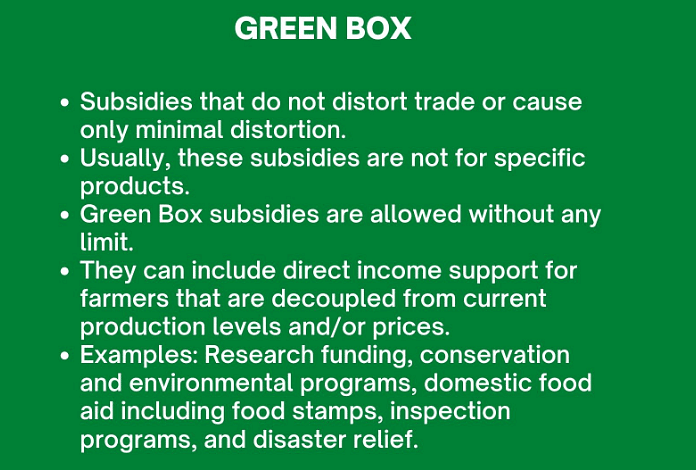WTO Agreement on Agriculture (AoA) | Agriculture Optional Notes for UPSC PDF Download
| Table of contents |

|
| Agreement on Agriculture |

|
| Features of WTO Agreement on Agriculture |

|
| WTO Agricultural Subsidies Boxes |

|
| Agreement on Agriculture Criticism |

|
Agreement on Agriculture
The Agreement on Agriculture (AoA) is a treaty within the framework of the World Trade Organization (WTO), which was negotiated during the Uruguay Round of the General Agreement on Tariffs and Trade (GATT) and officially approved in 1994 in Marrakesh, Morocco. The AoA became effective in 1995.
- According to its terms, developing nations were required to fulfill their reduction commitments by 2000, while developed countries had until 2004 to do so. Least Developed Countries were exempt from making any reduction commitments.
- The AoA pertains to agricultural products but does not include forestry, fishery products, as well as certain other specific items like rubber, sisal, jute, coir, and abaca.
- The primary focus of the AoA is the elimination of what is known as "trade-distorting" agricultural subsidies.
- As per the WTO's perspective, the overall objective of the Agreement is to establish a more equitable trading system that enhances access to markets and improves the well-being of farmers worldwide.
Features of WTO Agreement on Agriculture
Market Access
- Tariffication: This involves the conversion of all non-tariff barriers into tariffs. Non-tariff barriers encompass measures like variable levies, minimum import prices, quotas, state trading measures, and discretionary licensing, and these are to be eliminated.
- Tariff Reduction: Developing nations were required to reduce their tariffs by 24% over a decade.
- Access Opportunities: Minimum access, equivalent to 3% of domestic consumption in 1986-88, must be established by 1995, increasing to 5% by the end of the implementation period. This aims to improve market access by dismantling trade barriers.
Domestic Support
- This category pertains to the support and subsidies provided by countries to boost domestic agricultural production. The WTO has categorized these subsidies into different boxes, as explained in more detail below.
Export Subsidies
In this aspect, member countries commit to reducing export subsidies.
- Developed countries are mandated to cut their export subsidy volume by 21% and expenditure by 36% over six years, starting from 1986-1990 levels.
- Developing countries are required to decrease their export subsidy volume by 14% and expenditure by 24% over ten years in equal installments.
WTO Agricultural Subsidies Boxes
The domestic support subsidies are categorized into various boxes in the WTO. The various boxes and their implications are discussed in this section.
The images below describe the subsidies classified according to the WTO Boxes:


Special and Differential Treatment (SDT)
Certainly, here's a paraphrased version of the information regarding the special and differential treatment for developing countries and LDCs, often referred to as the Development Box:
- In addition to the three traditional boxes of subsidies, there is another category known as the Development Box. This category is designed to provide special and favorable treatment to developing countries and the least developed countries (LDCs).
- Under the Development Box, these countries are allowed to offer untargeted subsidized food distribution programs to address the needs of both urban and rural populations, especially the impoverished.
- They are also permitted to provide investment subsidies typically applicable to agriculture and extend agricultural input subsidies to low-income and resource-poor farmers.
- This includes activities related to the purchase and sale of food from food security stocks at government-set prices, with the condition that any subsidy granted to producers is factored into the calculation of the Aggregate Measure of Support (AMS).
- As part of Special and Differential Treatment (SDT), developed countries may be granted a temporary exemption from fulfilling their reduction commitments under the Agreement on Agriculture (AoA) for a period of ten years.
- It's important to note that, as of the current state of affairs, LDCs are not obligated to make any reduction commitments under the AoA, ensuring flexibility for their agricultural policies.
- Conversely, developed countries do not have access to the special and differential treatment (SDT) provisions provided in the Development Box, as these benefits are primarily directed towards developing countries and LDCs.
Agreement on Agriculture Criticism
Certainly, here's a paraphrased version of the points made by opponents of the Agreement on Agriculture:
- Detractors argue that the Agreement diminishes tariff protection for small-scale farmers, a significant income source in developing countries, while allowing affluent nations to persist in subsidizing their own agricultural sectors.
- Developed countries cleverly categorize their subsidies into trade-distorting (amber box) and non-trade-distorting (green box) to provide substantial support to their agriculture while accusing developing countries, like India, of engaging in trade-distorting practices.
- A collaborative study conducted by India and China revealed that countries like the United States, Canada, and the EU offer significantly higher subsidies to their farmers compared to the rest of the world.
- Developed countries continue to grant trade-distorting subsidies without facing penalties under the World Trade Organization (WTO).
- Under the Amber Box, developed nations have the option of accepting either a product-specific ceiling of 5% or an overall cap. By choosing the latter, most developed countries can better direct support to specific crops.
- Even with relatively modest subsidies, India faces the risk of exceeding the 10% limit on subsidies.
- Developed countries consistently scrutinize policies such as Minimum Support Price (MSP) in developing countries while maintaining support for their own farmers and imposing barriers on trade and market access.
- The WTO's drive towards globalization poses a threat to three crucial aspects of a sustainable and equitable agricultural policy: ecological security, livelihood security, and food security. This globalization trend can negatively impact producers with limited capital and investment.

|
Explore Courses for UPSC exam
|

|
















